Related Research Articles
Hindu deities are the gods and goddesses in Hinduism. The terms and epithets for deity within the diverse traditions of Hinduism vary, and include Deva, Devi, Ishvara, Ishvari, Bhagavān and Bhagavati.

Rudra is a Rigvedic deity associated with wind or storm, Vayu and the hunt. One translation of the name is 'the roarer'. In the Rigveda, Rudra is praised as the 'mightiest of the mighty'. Rudra is the personification of "destruction". Depending upon the periodic situation, Rudra can mean 'the most severe roarer/howler' (could be a hurricane or tempest) or 'the most frightening one'. Rudra is described as the lord who does total destruction at the time of great dissolution. The Shri Rudram hymn from the Yajurveda is dedicated to Rudra and is important in the Saivism sect.

In Hinduism and Buddhism, the Sanskrit lexical item svāhā is a denouement meaning "well said," indicating the end of a mantra. In the Tibetan language, "svaha" is translated as "so be it" and is often pronounced and orthographically represented as "soha". Whenever fire sacrifices are made, svāhā is chanted. Etymologically, the term is probably from su, "well" and the root ah, "to call".
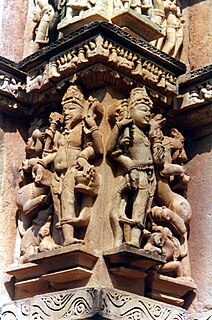
In Hinduism the Guardians of the Directions are the deities who rule the specific directions of space according to Hinduism, Jainism and Vajrayāna Buddhism—especially Kālacakra. As a group of eight deities, they are called Aṣṭa-Dikpāla (अष्ट-दिक्पाल), literally meaning guardians of eight directions. They are often augmented with two extra deities for the ten directions, when they are known as the Daśa-Dikpāla. In Hinduism it is traditional to represent their images on the walls and ceilings of Hindu temples. They are also often portrayed in Jain temples, with the exception that Nāga usually takes the place of Vishnu in the nadir. Ancient Java and Bali Hinduism recognize Nava-Dikpāla, literally meaning guardians of nine directions, that consist of eight directions with one addition in the center. The nine guardian gods of directions is called Dewata Nawa Sanga. The diagram of these guardian gods of directions is featured in Surya Majapahit, the emblem of Majapahit empire.

Puja or pooja is a worship ritual performed by Hindus to offer devotional homage and prayer to one or more deities, to host and honour a guest, or to spiritually celebrate an event. It may honour or celebrate the presence of special guest(s), or their memories after they die. The word "pūjā" is Sanskrit, and means reverence, honour, homage, adoration and worship. Puja, the loving offering of light, flowers, and water or food to the divine, is the essential ritual of Hinduism. For the worshipper, the divine is visible in the image, and the divinity sees the worshipper. The interaction between human and deity, between human and guru, is called darshan, seeing.

The historical Vedic religion, and subsequent Brahmanism, constituted the religious ideas and practices among some of the Indo-Aryan peoples of northwest India and the western Ganges plain of ancient India during the Vedic period. These ideas and practices are found in the Vedic texts.

Yajna or Yagya or Yagna literally means "sacrifice, devotion, worship, offering", and refers in Hinduism to any ritual done in front of a sacred fire, often with mantras. Yajna has been a Vedic tradition, described in a layer of Vedic literature called Brahmanas, as well as Yajurveda. The tradition has evolved from offering oblations and libations into sacred fire to symbolic offerings in the presence of sacred fire (Agni).
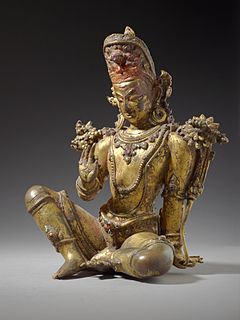
Deva means "heavenly, divine, anything of excellence", and is also one of the terms for a deity in Hinduism. Deva is a masculine term; the feminine equivalent is Devi.
Prayer or worship is considered to be an integral part of the Hindu religion. The chanting of mantras is the most popular form of worship in Hinduism. Yoga and meditation are also considered as a form of devotional service. The adjacent picture represents the Om sign, which is a sacred sound and a spiritual symbol in Hinduism.

Prasāda, variantly spelled as Prasādam, Prasād and Prasāda, is a material substance of vegetarian food that is a religious offering in both Hinduism and Sikhism. It is normally consumed by worshippers after worship. Mahaprasāda in Hinduism, similar to the langar in Sikhism, is the consecrated food offered to the deity in the temple which is then shared and eaten by the masses without discrimination. Sometimes this vegetarian offering will exclude the prohibited items such as garlic, onion, roots, etc.
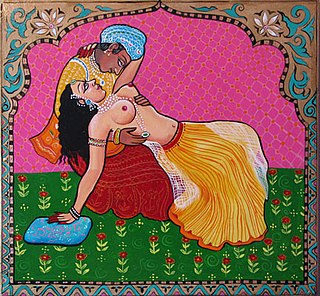
Kama means "desire, wish, longing" in Hindu and Buddhist literature. Kama often connotes sexual desire and longing in contemporary literature, but the concept more broadly refers to any desire, wish, passion, longing, pleasure of the senses, desire for, longing to and after, the aesthetic enjoyment of life, affection, or love, enjoyment of love is particularly with or without enjoyment of sexual, sensual and erotic desire, and may be without sexual connotations.

Hiraṇyagarbha is the source of the creation of universe or the manifested cosmos in Vedic philosophy, as well as an avatar of Vishnu in the Bhagavata Purana. It finds mention in one hymn of the Rigveda, known as the Hiraṇyagarbha Sūkta, suggesting a single creator deity, identified in the hymn as Prajāpati. The concept of the "golden womb" is first mentioned in the Vishvakarma Sūkta which picturized the "primeval womb" as being rested set upon the navel of Vishvakarman the Supreme cosmic creator, that One wherein abide all things existing. This imagery was later transferred to Vishnu.

In the Vedic Hinduism, a homa also known as havan, is a fire ritual performed usually on special occasions by a Hindu priest for a homeowner. The grihasth keeps different kinds of fire including one to cook food, heat his home, amongst other uses; therefore, a Yagya offering is made directly into the fire A homa is sometimes called a "sacrifice ritual" because the fire destroys the offering, but a homa is more accurately a "votive ritual". The fire is the agent, and the offerings include those that are material and symbolic such as grains, ghee, milk, incense and seeds.

Pashupata Shaivism is the oldest of the major Shaivite Hindu schools. The mainstream which follows Vedic Pasupata penance are 'Maha Pasupatas' and the schism of 'Lakula Pasupata' of Lakulisa.
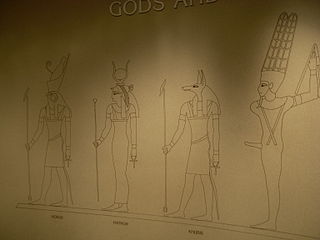
Polytheism is the worship of or belief in multiple deities, which are usually assembled into a pantheon of gods and goddesses, along with their own religions and rituals. In most religions which accept polytheism, the different gods and goddesses are representations of forces of nature or ancestral principles, and can be viewed either as autonomous or as aspects or emanations of a creator deity or transcendental absolute principle, which manifests immanently in nature.
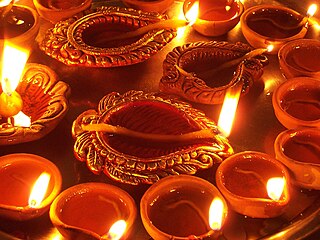
Worship in Hinduism is an act of religious devotion usually directed to one or more Hindu deities. A sense of Bhakti or devotional love is generally invoked. This term is probably a central one in Hinduism, but a direct translation from the Sanskrit to English is difficult. Worship takes a multitude of forms depending on geography and language. Worship is not confined to any place of worship, and it will often incorporate personal reflection, music, dance and poetry. Hindus usually perform worship in temples or at home to achieve some specific end or to integrate the body, mind and spirit. The aim is to live a pure life in order to help the performer reincarnate into a higher being.

The Devi Upanishad, is one of the minor Upanishads of Hinduism and a text composed in Sanskrit. It is one of the 19 Upanishads attached to the Atharvaveda, and is classified as one of the eight Shakta Upanishads. It is, as an Upanishad, a part of the corpus of Vedanta literature collection that present the philosophical concepts of Hinduism.

The Ahom religion is the ethnic religion of the Ahom people. The Ahom people came into Assam in 1228, led by a Tai prince Sukaphaa, and admixed with the local people. The people who came into Assam included two clans of priests, joined later by a third, who brought with them their own religion, rituals, practices and scriptures. The religion is based on ritual-oriented ancestor worship that required animal sacrifice (Ban-Phi), though there was at least one Buddhism influenced ritual in which sacrifice was forbidden (Phuralung).. Ancestor worship and the animistic concept of khwan are two elements it shares with other Tai folk religions. There is no idolatry except for the titular god of the Ahom king and though there is a concept of heaven or a heavenly kingdom, there is no concept of hell. It was the state religion of the Ahom kingdom in the initial period.
The Taittirīya Brāhmaṇa is a commentary on the Krishna Yajurveda. Considered by academics to be an appendix or extension of the Taittirīya Samhita, the first two books (ashṭakas) largely consist of hymns and Mantras to the Vedic-era Devas, as well as Mythology, astronomy, and astrology ; the third book contains commentaries and instructions on Vedic sacrificial rites such as the Purushamedha, Kaukili-Sutramani, Ashvamedha, and Agnicayana.
References
- ↑ The Aitareya Brahmanam of the Rigveda Martin Haug - 1863 "The technical meaning of an ishti is a series of oblations to different deities, consisting chiefly of Purodds'a. An dhuti or uti, which appears to be an older name of the same idea (this meaning is quite omitted in the Sanscrit Dictionary ..."
- ↑ Hindu World: An Encyclopedic Survey of Hinduism Benjamin Walker - 1968 - It consists of ishti, i.e. butter, fruit and grains; the midday ishti, called the prishtha, is generally accompanied by stotra (hymns) and sdmans (chants). Offerings of cakes ...
| This Hinduism-related article is a stub. You can help Wikipedia by expanding it. |